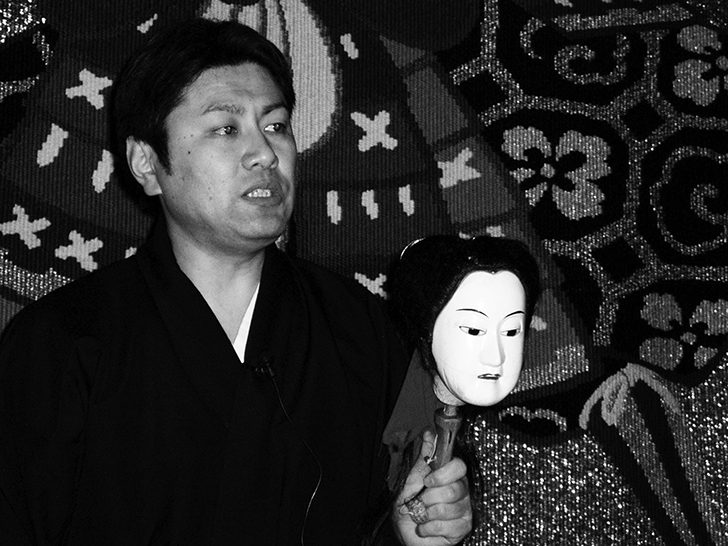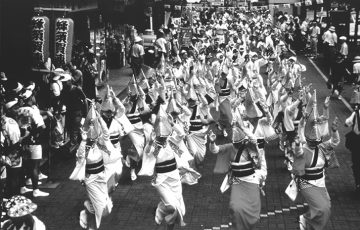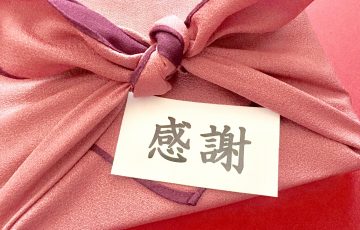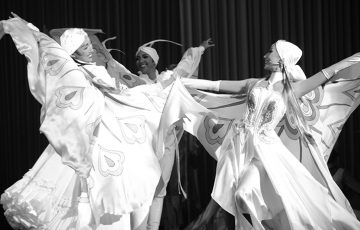How many Japanese people does it take to operate a doll? If the doll happens to be one of the intricate dolls used traditional Japanese Bunraku, also called “Joruri Puppet Theater” or “ningyo joruri” in Japanese, the answer is three. These dolls that can weigh up to 15 kilograms (33 pounds) and are about one-half to two-thirds the height of a human are capable of detailed movement and are operated with such skill that even though their faces are made of wood, to the viewer they come to life showing a wide range of emotions from joy to despair. The art of Joruri Puppet Theater is a must-see event even for the most casual Japanese culture fan.
Joruri Puppet Theater melds traditional Japanese music that includes a shamisen (a three-stringed Japanese banjo-like instrument), sometimes a drum, and a narrative, with puppet actors. In Joruri Puppet Theater the puppet operators, individuals cloaked head-to-toe in black known as kuroko, operate puppets bringing them to life as they play the main roles in a traditional folktale being told by the narrator, known as the joruri, against a background of shamisen music. The Joruri Puppet Theater as we know it today is said to have originated on Awaji Island in Japan more than 500 years ago, and was recognized as a one of the masterpieces of the Oral and Intangible Heritage of Humanity by UNESCO in 2003.
Today quality Joruri Puppet Theater can be seen at the The National Bunraku Theater located in Osaka, or in Tokyo at the National Theater. Tickets for the Tokyo location generally sell out far in advance due to its immense popularity and scarcity of shows. Seeing the dolls in motion is a real treat as it is a beautiful and expressive art-form performed by true professionals.
As mentioned, each doll is operated by three individuals known as kuroko who are dressed entirely in black. The kuroko are usually completely covered in black, including a black hood that they wear to hide their heads, and black gloves to hide their hands. Sometimes the lead master puppeteer may leave his face uncovered, but this only occurs when the master is indeed an individual of extremely advanced skill who has made a name for himself. Unlike Western puppets no strings are used in the operation of a Japanese Bunraku doll, instead the kuroko handle the doll directly. The lead kuroko controls the doll’s head with his left hand and the right arm of the doll with his right. The second kuroko controls the doll’s left arm, and the third kuroko controls the doll’s feet and can make the doll do things such as run or sit.
As in many traditional Japanese art forms, there is a strict hierarchy of seniority at work here. Normally a kuroko must gain experience operating the feet for at least 10 years before he can be promoted to the left arm. Another 10 to 15 years of operating the left arm and a kuroko may become the lead earning himself the right to operate the head and right arm. Since three people are operating the same doll, their movements must be in unison so intensive practice as a group is a must before they are able to give a performance. In contrast to the black cloaks of the kuroko, the dolls themselves often wear elaborate kimono’s on the outside, but underneath lie the mechanisms that allow the dolls to come to life.
A complex trigger attached to the back of the doll’s neck allows the lead kuroko to control the dolls facial expressions. The extent to which the facial expressions can be controlled is astounding. The operator can make the dolls head nod, he can raise and lower the doll’s eyebrows to show surprise or anger, he can change the direction that the doll’s eyes are looking by moving the eyeballs (this indeed is an incredible effect), and he can open and close the doll’s mouth. Note, opening and closing the mouth is not done to allow the doll to “speak,” rather it is used to show laughter and other expressions. The arms also have a mechanism that allow the kuroko to open and close the dolls hands.
Though the kuroko are dressed entirely in black and remain as quiet as possible, their presence remains obvious to the audience. The intent is not to completely hide the kuroko from view, but simply to make them less of a distraction from the puppet. The entire effect is more believable than can be adequately described in words. Minor details are attended to in order to maintain the illusion that the doll is alive. As humans are only completely still when dead, the same goes for the dolls. The kuroko are constantly moving the doll even in the slightest so that it literally appears to be breathing even if the doll is sitting still or asleep.
On a visit to Awaji Island I had the opportunity to see a Joruri Puppet Show. Though this trip was more than a few years ago now, I clearly remember my amazement when the doll was made to cry. The way the doll shuddered, and the lonely sound of the shamisen was all so convincing, I could almost see tears streaming down the dolls wooden face. The ability of the kuroko to operate the dolls of Joruri Puppet Theater is truly a sight to behold.
Story by Harvey Beasley
From J SELECT Magazine, April 2009















Recent Comments